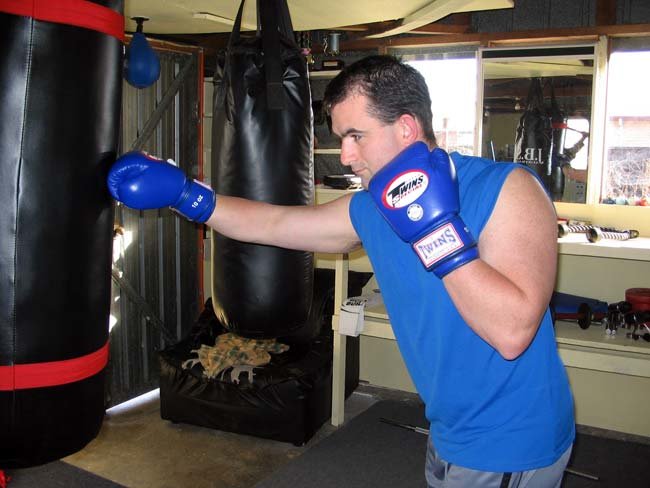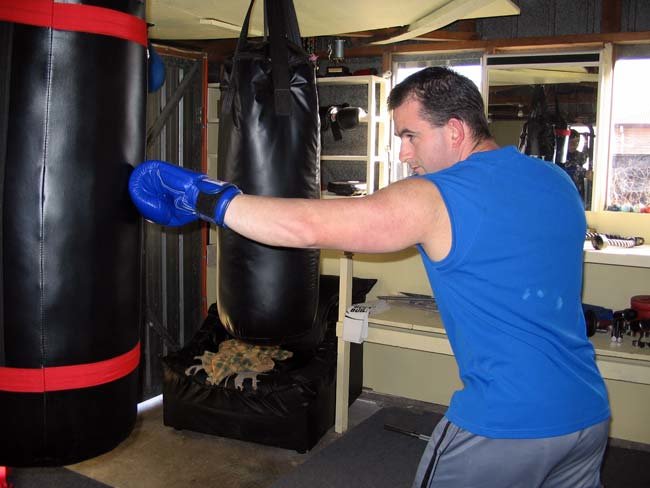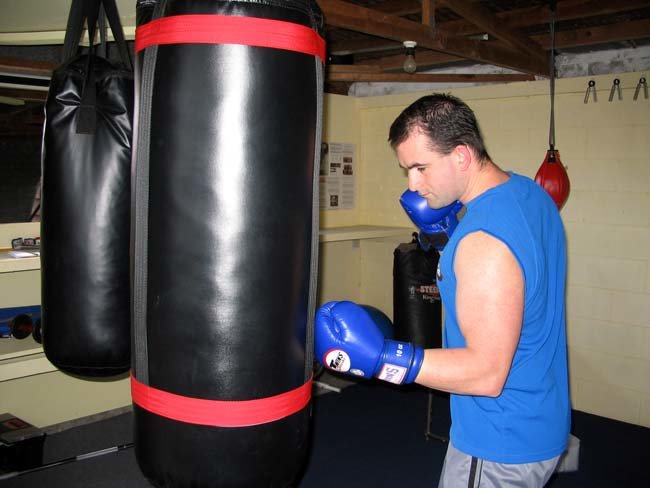With the advent of sophisticated training devices, and methods to achieve amazing results in minimal time, the fitness industry is increasingly veering away from many tried and tested ways to improve health and fitness.
One piece of equipment that has become almost legendary in its shaping of champions, and the results in physical fitness it has achieved for many an average person, is the heavy bag.
The heavy bag is a stuffed bag made of leather or vinyl, which weighs between 40 and 100 pounds, and is used primarily among boxers for building punching power and improving boxing technique. Hitting the heavy bag is physically demanding and a true test of strength and stamina.
For a relatively simple piece of equipment, it delivers many amazing benefits. Whether it be a full-body workout, sharpened self-defense skills, or a defined, muscular body, the heavy bag is a valuable addition to any home, or commercial gym setting.
How does one use the heavy bag and what are its benefits? Why might the heavy bag be a useful addition to your training plan? Read on to find out.
Benefits Of Heavy Bag Training
1. Improve Aerobic Fitness
Training on the heavy bag at the right intensity, will greatly tax the cardio respiratory system. The mere act of moving around a bag, while changing body position, equates to an aerobic (utilizing oxygen at a lower intensity) workout.
Throwing punches with bad intentions will add an anaerobic (higher intensity) dimension while adding to the aerobic workload. Most bag sessions last for a minimum of two minutes.
Professionals typically sustain their high intensity punching and moving for three minutes. Occasionally, I will box the heavy bag for a 5-minute round.
This saves time due to the need for fewer rest periods, and provides a greater workout overall. However, the ability to do this must be developed over time, so there should be no rushing into this type of training.
To realize any aerobic benefit, it is important to build up to at least two minutes, and increase this to three, as aerobic capacity increases.
2. Improve Power
The heavy bag was actually designed for boxers to enhance their punching power. It allows for the perfect opportunity to focus on using as many muscles as possible, to ensure a punch is thrown with perfect technique, and with the greatest possible force—the bag never hits back.
Main muscles worked on the heavy bag include the shoulders, arms, back, chest and waist. Legs are also used in the process of punching the bag, to generate power through the upper body.
Straight punches, such as the right cross and jab, will help develop power through the shoulders and chest, while uppercuts and hooks will utilize the back and arms to a greater extent.
3. Improve Coordination And Core Stability
Circling the heavy bag and throwing off combinations of punches will help with coordination. Keeping on the toes, and transferring weight from one foot to the other, to throw a specific punch, will help develop core stability, and, as a result, overall body coordination.
Coordination has obvious implications for how one moves, and performs, on a daily basis. Boxers, with a large degree of experience on the heavy bag, tend to exhibit excellent posture and move with a certain grace.
4. Improve Boxing Technique
Obviously, hitting the heavy bag will improve boxing technique, provided all punches, and body-movements, are performed correctly. The idea is to keep everything tight, while remaining relaxed and ready to react.
Elbows in and hands up, while continually moving, is the basic approach to hitting the heavy bag. Of course, the punches will be all the more sharper and powerful if one is relaxed, and in the correct stance.
5. Develop Self Defense Skills
The bag cannot retaliate, therefore making it the ideal way in which to perfect self defense technique. Visualize the bag as an opponent and hit as if being hit.
In other words, use lateral movement, and bob and weave to set up a punch, or series of punches, on the premise that the bag is a living breathing opponent throwing its own combination of punches.
Try swinging the bag to make it a moving target. This will make it harder to hit, and improve the workout's real-life application. Hitting the heavy bag will also build confidence translatable to a real life situation.
Building power and developing technique on the heavy bag, will better prepare boxers to respond when it is needed (in the boxing ring or on the street).
6. Improve Body Shape
I have personally witnessed an improvement in terms of shoulder, biceps and back detail, as a result of heavy bag training. Although hitting the heavy bag does not equate to a pure bodybuilding workout—as would weight-training—it does provide an excellent way in which to add detail and strip body-fat.
Adding detail in the form of greater cuts and a certain hardness, and stripping body-fat to reveal the underlying muscles, will enhance anyone's physique.
For the amount of work many boxers do—particularly in the pro ranks—many of these athletes seem to hold an impressive degree of muscle size. For those wanting to improve general health, while preserving their muscle gains, I would suggest following program one at the end of this article.
7. Decrease Stress
It has been accepted for some time now that hitting the heavy bag is one way to dissolve negative stress. Although any form of exercise has special stress-countering qualities, boxing is probably unique in that it is a physically exhausting, aggressive, activity, which demands total concentration while allowing one to literally strike-out at an inanimate object.
This striking out aspect is thought to allow a channeling of the aggressive tendencies we all have, into something of benefit to mind and body. Due to our increasingly hectic lifestyles, we continually face an inherent urge to act in a physical manner, on various stressors.
Unfortunately, the position we are in often precludes us from physically confronting, or running from, a particular stressor. Hitting the heavy bag, like any intense activity, allows one to act in a physical manner, to vent the build up of toxins that form as a result of the inherent stressfulness of their lives.
This aside, hitting the heavy bag also provides great aerobic/anaerobic benefits, which have conclusively been proven to help lower stress levels.
8. A Low Cost Activity, Requiring Minimal Equipment
Hitting the heavy bag is an activity that requires minimal equipment, therefore making it low cost and relatively easy to set up. A bag, some wraps, and a good pair of gloves are the only mandatory requirements.
A good set of shoes and a flat surface, with enough surrounding room to move at least three feet in either direction of the bag, are to be considered also. With its many benefits, hitting the heavy bag is an ideal addition to a regular exercise program.
Heavy Bag Tips
1. Prepare Properly
Before hitting the heavy bag, it is imperative that all safety aspects are addressed, to help offset injury, while ensuring a productive session.
Wraps
Preparing to hit the bag could prove to be the most vital element when it comes to positive, long-term results. Begin by applying wraps to the knuckles and wrist area.
These are specifically designed to provide support for entire hand and wrist area. Training without wraps could, over time, lead to hand and wrist damage, so wearing them is the first crucial step to longevity in the sport.
Hand-wrapping to absorb impact will also help to lessen the likelihood of osteoarthritis in later years.
Gloves
After wraps, place on gloves that are suitable for ones specific purposes. Lighter gloves (10-ounce) are usually used on the heavy bag by beginners, and/or those wanting to perfect their technique.
The heavier gloves typically are used by stronger, more experienced, athletes, to prepare them for battle, when they will be wearing lighter gloves (heavier gloves will help to develop hand speed).
When buying gloves, it is best to stick with a reputable, more expensive brand. This will help ensure a better quality workout and a longer-lasting pair of gloves.
Shadow Boxing
A brief warm-up of shadow boxing (punching into thin air, using the reflection in the mirror as an opponent), followed by a series of joint rotation exercises, is generally a good idea before starting on the heavy bag.
2. Begin Light
As part of the warm-up, one light 2-to-3-minute round is advisable. Circle the bag and throw off light punches using excellent technique.
This will also serve to form the correct groove, and help ensure this sharpness remains throughout the session. It is actually better to go light, with perfect form, than to use incorrect technique and become injured.
3. Always Emphasize Correct Technique
Never hit the bag hard at the expense of proper technique. This maxim should always be in mind when seeking to make physical improvements on the heavy bag.
Wading into a heavy bag without consideration for technique will not only increase the likelihood of injury, but result in stifled progress. It is worth remembering that power and speed will come as a result of correct technique, rather than the other way around.
4. Throw All Punches From Fighting Stance
It is never a good idea to telegraph punches in an attempt to generate more power. This will let your opponent know exactly what is coming next, and give them the chance to preempt your attack.
On the heavy bag, this same rule applies. Telegraphing will encourage sloppy form and unnecessarily result in lessened energy reserves—two things any boxer, whether training for a fight or simply using the bag to get in shape, should avoid at all costs.
Extrapolating a heavy bag session to a real-life situation involves keeping all fundamental precepts the same. Never sacrifice technique on the heavy bag.
5. Use A Near Full Extension When Hitting The Heavy Bag
Distancing is an important consideration when aiming to exert maximal force on the heavy bag. Standing too close will result in a pushing motion, which will achieve minimal results. Stand too far away, and minimal contact will be made.
Standing at the right distance will allow for a near full extension as each punch hits the bag. A clean, crisp, sound should result from a near full extension punch. Try to punch through the bag, like it is an opponent.
6. Breathe Correctly
When hitting the bag, it is tempting to hold your breath due to the exertion needed to execute each punch. Exhaling as a punch is thrown will help ensure a continual supply of oxygen to the body, to feed the working muscles. It will also decrease the likelihood of thoracic pressure, which can result in serious injury.
Thoracic pressure is created when nerves and muscles in the thoracic region—between the first rib and collarbone—become compressed, resulting, in some cases, an eye hemorrhage, high blood pressure and severe headaches. To further underscore the importance of correct breathing for boxing purposes, exhaling with each punch will also add increase power output.
7. Ensure Diet & Rest Needs Are Met
With the type of affect heavy bag training has on all the muscles of the body, it is vital to ensure all nutritional and rest needs are met. It is important to eat about 150 grams of carbohydrates, in addition to taking a protein shake, at least one hour before training.
Again, following training, a protein shake and 150 grams of carbohydrates might be taken. This will help with the recovery process, and ensure regular gains are made.
Good sleep—7-9 hours a night—is also important to facilitate a beneficial training response.
Heavy Bag Programs
Training Considerations
The heavy bag routine comprises several components, all of which should be used, to some extent, during any given workout.
1. Drilling The Technique
This basically involves repetitively practicing certain punches. For example, a straight right might be executed 20-times, followed by a short rest.
Drilling techniques can be made very hard, or kept at a lesser intensity, depending on ones fitness level. They provide and excellent opportunity to go all out, and really push heavy bag work to the limit, without risking technical sacrifice.
2. Times Rounds
The ability to sustain an intense workload for a period of time is the essence of boxing, and indeed training for general fitness and physical improvement on the heavy bag. With timed rounds, all the punches should be practiced with attention given to the advice provided in this article.
Circle the bag picking punches at regular, closely-spaced intervals, rather than going all out and tiring in the first minute or so. The key here is to keep the intensity high, without pre-maturely exhausting oneself. As one becomes more proficient, the intensity can be increased to where an all out effort can be given.
3. Circuit Training With Weights
This can be attempted by anyone with an established aerobic base. It involves going from a heavy bag technique to a related weight exercise.
The possibilities are only limited by imagination, with a near infinite number of combinations. For example, I would suggest going from one minute of left-right combinations, directly to front raises with dumbbells, or bent side laterals. The key here is to keep the weights sufficiently light.
Punches
The punches used in all heavy bag routines include:
Straight (Cross) Right, or Left

Straight Right
Overhand Right, or Left
To perform an overhand right, or left, lift elbow as a regular right cross punch is thrown, and target the fist at a point slightly above the temple region. This movement is often used by shorter fighters, to score a knockout against their taller opponent.
Right, Or Left, Jab

Left Jab
Left And Right Hook

Left Hook
Left And Right Uppercut

Program 1: Monday And Thursday
For the purposes of developing appreciable muscle density, improving cardiovascular fitness, and enhancing general fitness (bearing in mind the average reader of this site seeks muscle quality and improved fitness levels), I would recommend the following program.
Due to the intensity of the following training program, and the additional training required to address muscle size and general health, two days a week is sufficient. This session should take around 50 minutes to complete.
Warm-Up
- 5-minutes on bike
- 5-minutes of joint rotations for legs waist, arms and shoulders. With these, form circles varying from large to small, at each joint
- Light stretching of all major muscle groups
Part 1: Drilling The Basic Punches
- 25 right (or left) cross punches
- 25 left (or right) jab punches
- 25 left uppercuts
- 25 right uppercuts
- 25 left hooks
- 25 right hooks
Part 2: Combinations
The idea here is to string together several basic punches, for a more intense workout.
Complete 3 sets of each of the following combinations:
- Left uppercut, right cross, left hook
- Left (or right) jab, right (or left) cross, left (or right) jab
- Right cross (or left), left hook (or right), right cross (or left)
- Left (or right) jab, right (or left) cross, left (or right) jab, right (or left) cross, left (or right) hook
Part 3: 5 Rounds Of Boxing
With this component, focus on executing all the major punches, as practiced in Part 1. Circle the bag, and pick shots as if the bag was a countering opponent.
Each round should be 2 minutes, with 1 1/2 minutes rest between rounds.
Cool Down
- 5-minutes on bike
- Light stretching
Program 2
For the more advanced trainer, someone wanting to pursue boxing as a sport, I would recommend the following heavy bag program. This program will help one to become a supremely conditioned fighting machine. A lean, muscular physique will result.
This program is more intense, therefore a good level of fitness is required before attempting it. Program can be done on Mondays, Wednesdays and Fridays, so as to accomplish an extreme level of fitness. This session should take about 1 1/2 hours to complete.
Warm-Up
- 5-minutes on bike
- 5-minutes of joint rotations for legs waist, arms and shoulders. With these, form circles varying from large to small, at each joint
- Light stretching of all major muscle groups
Part 1: Drilling The Basic Punches
- 40 right (or left) cross punches
- 40 left (or right) jab punches
- 40 left upper cuts
- 40 right uppercuts
- 40 left hooks
- 40 right hooks
Part 2: Combinations
Complete 5 sets of each of the following combinations:
- Left uppercut, right cross, left hook
- Left (or right) jab, right (or left) cross, left (or right) jab
- Right cross (or left), left hook (or right), right cross (or left)
- Left (or right) jab, right (or left) cross, left (or right) jab, right (or left) cross, left (or right) hook
Part 3: 10 Rounds Of Boxing
Each round should be 3 minutes, with 1 minute's rest between rounds.
Cool down
- 5 minutes on bike
- Light stretching
Conclusion
Heavy bag training is a special, yet traditional, way in which to build supreme cardiovascular stamina and muscle strength. It will also help to develop valuable self-defense skills, and decrease stress.
The programs outlined in this article are extremely beneficial whether the goal is to become a great boxing champion, or simply more fit and strong in general.
The heavy bag is one piece of equipment that is easy to use and as effective, if not moreso than much of the latest hi-tech machinery. Use it today.

